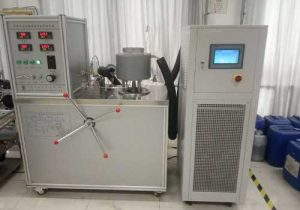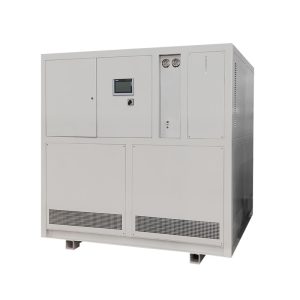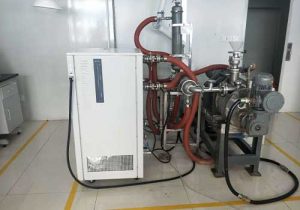storage chiller
Working Principles
Most storage chillers operate on the vapor – compression refrigeration cycle, which consists of four main components and stages:

Compression: The compressor is the heart of the chiller system. It takes in low – pressure, low – temperature refrigerant vapor and compresses it, increasing both the pressure and temperature of the refrigerant. As the refrigerant gas is compressed, its molecules are forced closer together, converting mechanical energy into thermal energy. This results in a high – pressure, high – temperature vapor.
Condensation: The hot, high – pressure refrigerant vapor then enters the condenser. In an air – cooled storage chiller, the condenser releases heat to the surrounding air through a series of fins and fans. In a water – cooled chiller, heat is transferred to a separate water loop, which may be connected to a cooling tower. As the refrigerant loses heat, it undergoes a phase change from vapor to liquid, becoming a high – pressure, warm liquid.
Expansion: The high – pressure liquid refrigerant next passes through an expansion valve. This valve reduces the pressure of the refrigerant dramatically, causing it to expand and cool down significantly. The sudden drop in pressure leads to a portion of the liquid refrigerant evaporating, resulting in a low – pressure, low – temperature mixture of liquid and vapor.
Evaporation: Finally, the low – temperature refrigerant mixture enters the evaporator, which is located inside the storage chiller. Here, the refrigerant absorbs heat from the air or products within the chiller, causing the temperature inside the chiller to drop. As the refrigerant absorbs heat, it completely evaporates back into a low – pressure vapor, which is then drawn back into the compressor to start the cycle anew.
Types of Storage Chillers
Walk – in Chillers
Walk – in chillers are large – scale storage units that allow personnel to enter the chilled space. They are commonly used in commercial kitchens, supermarkets, and food distribution centers. These chillers can be customized in size and layout, with options for multiple shelves, racks, and doors. Walk – in chillers typically have a temperature range from around 0°C to 10°C, making them suitable for storing a wide variety of perishable foods such as fresh produce, dairy products, and meats.
Reach – in Chillers
Reach – in chillers are smaller in size compared to walk – in chillers and are designed for easy access without the need to enter the unit. They are often found in convenience stores, cafes, and small restaurants. These chillers usually have glass doors, allowing customers or staff to view the stored products. Reach – in chillers come in different capacities and configurations, and their temperature range also typically falls between 0°C and 10°C.
Blast Chillers
Blast chillers are specialized units designed to rapidly reduce the temperature of hot food products. They can quickly cool food from cooking temperatures (e.g., 70°C) down to refrigeration temperatures (e.g., 3°C) within a short period, usually within 90 minutes. This rapid cooling helps prevent the growth of bacteria and preserves the quality and safety of the food. Blast chillers are commonly used in commercial kitchens, catering services, and food processing facilities.
Key Features

Temperature Control
Precision temperature control is a critical feature of storage chillers. The ability to maintain a consistent temperature within a narrow range is essential for preserving the quality of stored items. Modern storage chillers often come with digital temperature controllers that allow for accurate setting and monitoring of the temperature. Some advanced models can maintain the temperature within ±0.5°C.
Capacity
Storage chillers are available in a wide range of capacities, from small units with a few cubic feet of storage space to large walk – in chillers that can hold thousands of cubic feet. The capacity required depends on the quantity and size of the items to be stored. For example, a small bakery may need a reach – in chiller with a capacity of 5 – 10 cubic feet, while a large supermarket may require a walk – in chiller with a capacity of several hundred cubic feet.
Energy Efficiency
Energy – efficient storage chillers help reduce operating costs and environmental impact. Features such as insulated walls, high – efficiency compressors, and smart control systems contribute to energy savings. Some chillers are designed with variable – speed compressors that adjust the cooling capacity based on the actual load, consuming less energy during periods of low demand.
Shelving and Interior Design
The interior design of a storage chiller, including the type and arrangement of shelving, can impact its usability. Adjustable shelves allow for flexibility in storing items of different sizes. Some chillers also come with features like sliding shelves, which make it easier to access items at the back of the unit.
Applications
Food and Beverage Industry
In the food and beverage sector, storage chillers are used extensively. Restaurants, cafes, and catering services rely on them to store fresh ingredients, prepared foods, and beverages. Supermarkets and grocery stores use walk – in and reach – in chillers to display and store perishable products, ensuring they remain fresh until purchased by customers. The food processing industry also uses blast chillers to cool cooked foods quickly for safe storage and distribution.
Pharmaceutical Industry
The pharmaceutical industry requires precise temperature control for the storage of medications, vaccines, and other biological products. Storage chillers with strict temperature monitoring and control systems are used to maintain the stability and efficacy of these products. Vaccines, for example, often need to be stored within a specific temperature range, typically between 2°C and 8°C, to remain viable.
Floristry
Florists use storage chillers to keep flowers fresh for longer periods. By storing flowers in a cool environment, the rate of respiration and water loss is reduced, extending their vase life. Walk – in chillers with proper humidity control are ideal for storing large quantities of cut flowers, while smaller reach – in chillers can be used in flower shops for displaying and storing ready – to – sell arrangements.
Chemical and Laboratory Storage
In laboratories and chemical storage facilities, certain chemicals and samples need to be stored at low temperatures to prevent degradation or chemical reactions. Storage chillers provide a controlled environment for the safe storage of these substances. They are also used to store biological samples, such as blood, tissue, and cell cultures, which require specific temperature conditions to maintain their integrity.
Considerations for Choosing and Maintaining Storage Chillers

Choosing the Right Storage Chiller
Size and Capacity: Assess the amount of storage space needed based on the quantity and size of the items to be stored. Consider future growth as well, to avoid the need for frequent upgrades.
Temperature Requirements: Different products have different optimal storage temperatures. Ensure that the chiller can maintain the required temperature range accurately.
Type of Chiller: Select the appropriate type (walk – in, reach – in, or blast chiller) based on the application. For example, if rapid cooling of large quantities of food is required, a blast chiller is the best choice.
Energy Efficiency: Look for chillers with high energy – efficiency ratings to reduce long – term operating costs.
Brand and Warranty: Choose a reputable brand with a good track record for reliability. A comprehensive warranty can provide peace of mind and cover potential repair costs.
Installation
Proper installation is crucial for the efficient operation of a storage chiller. Ensure that the installation location is level, well – ventilated, and has access to a reliable power source. For air – cooled chillers, leave sufficient space around the unit for proper air circulation. In the case of water – cooled chillers, connect them to a suitable water supply and drainage system following the manufacturer’s instructions.
Maintenance
Regular Cleaning: Clean the interior and exterior of the chiller regularly to remove dirt, debris, and spills. This helps prevent the growth of bacteria and maintain the aesthetic appeal of the unit. Clean or replace the air filters as recommended by the manufacturer to ensure proper air circulation.
Temperature Monitoring: Regularly check the temperature inside the chiller using a calibrated thermometer to ensure that it is within the desired range. If any discrepancies are found, adjust the temperature settings or have the chiller serviced.
Refrigerant Level Check: Periodically inspect the refrigerant level. Low refrigerant levels can lead to reduced cooling performance. If a refrigerant leak is suspected, have it repaired promptly by a qualified technician.
Component Inspection: Check the compressor, fans, and other components for any signs of wear, damage, or abnormal noise. Lubricate moving parts as per the manufacturer’s instructions to ensure smooth operation.
In conclusion, storage chillers play a vital role in preserving the quality and safety of a wide range of products across multiple industries. Understanding their working principles, types, features, applications, and maintenance requirements is essential for making informed decisions when choosing and operating these cooling systems. By ensuring proper selection, installation, and maintenance, businesses can rely on storage chillers to provide reliable and efficient cold storage solutions.
Related recommendations
What are the Lubrication Methods for Industrial Chillers?
1445What are the Lubrication Methods for Industrial Chillers? During the operation of the industrial chiller, the compressor of the equipment sucks the low-temperature and low-pressure refrigeran...
View detailssplit air cooled chiller
205Introduction to Split Air - Cooled ChillersSplit air - cooled chillers are a type of refrigeration system that divides its components into two main parts: an indoor unit and an outdoor unit. Unli...
View detailsHow to deal with insufficient water flow in the water cooled chiller?
1389How to deal with insufficient water flow in the water cooled chiller? The temperature control of the production process is imbalanced, even leading to severe production problems and acc...
View detailsLow Temperature Chiller Equipment for Hydrogen Production Machine
1766Low Temperature Chiller Equipment for Hydrogen Production Machine In the hydrogen production process of water electrolysis, once the temperature rises uncontrollably, the hydrogen production...
View details
 LNEYA Chiller
LNEYA Chiller







HelloPlease log in